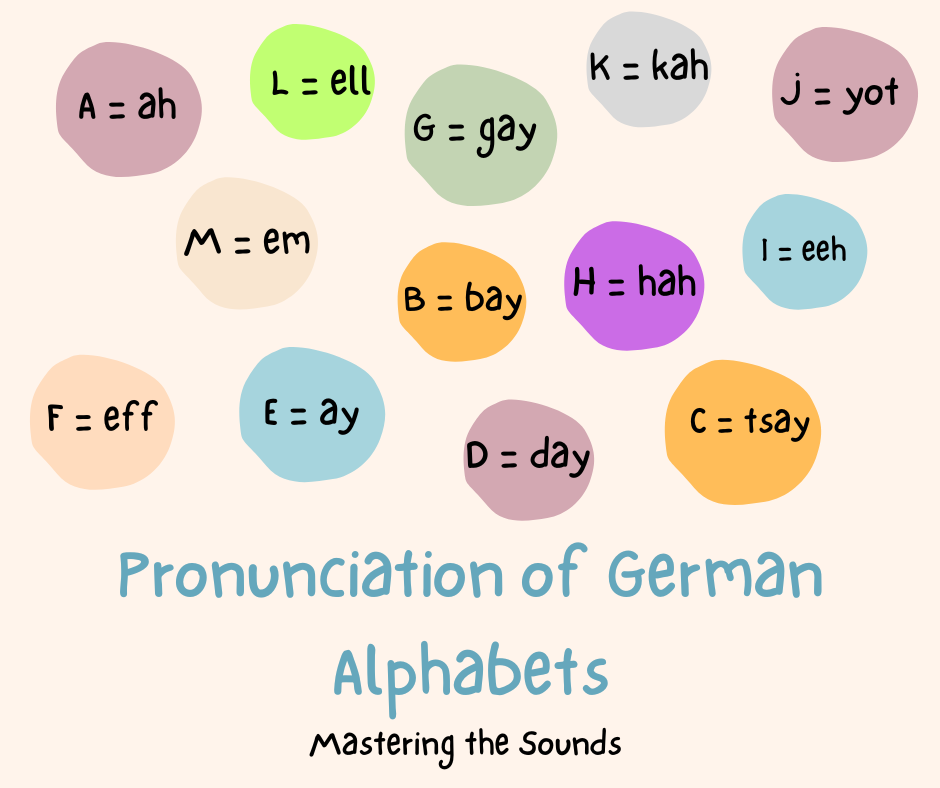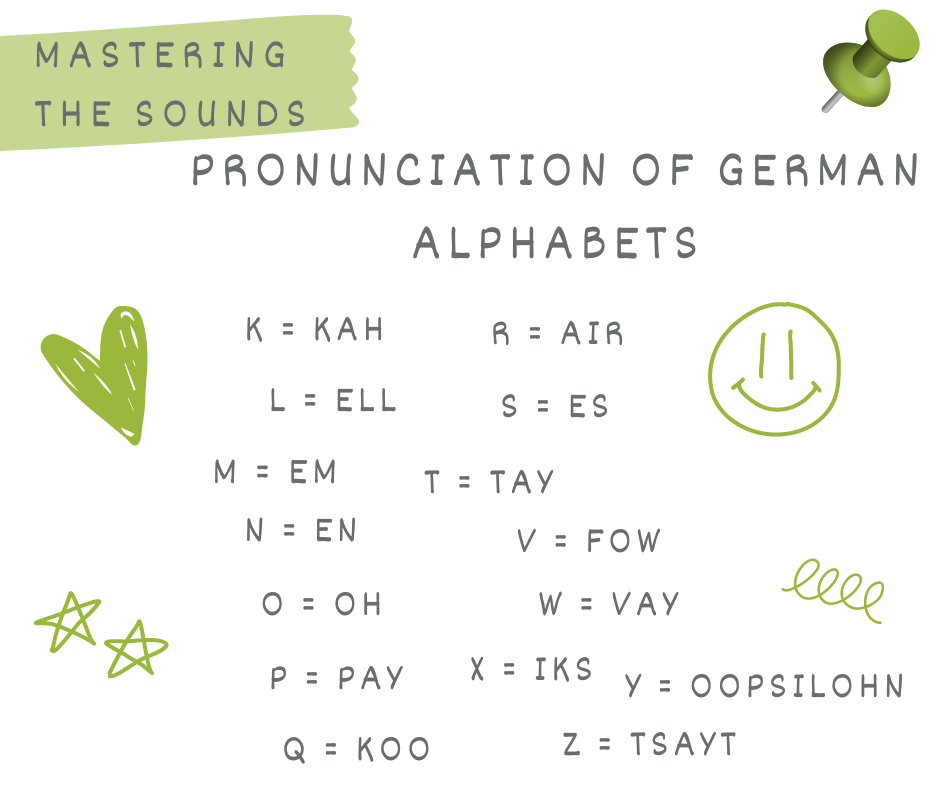Have you ever felt intrigued by the German alphabet, with its unique characters and symbols? You’re not alone! But here’s the exciting part: mastering this code is simpler than you might think, and it’s the key to unlocking a whole new world of language and culture. Imagine the thrill of reading street signs and menus and even having basic conversations in German during your trip to Germany. Learning the German alphabet can make all this possible, enhancing your travel experiences and cultural understanding!
Think of it this way: just as you know your ABCs in English, you’re already ahead of the game in German. Yes, it’s that simple! German has all the familiar letters you’re used to, plus a few surprises. And once you get the hang of them, you’ll be amazed at how quickly you can start putting words together and speaking German like a pro. Learning the German alphabet is a breeze, and it’s the first step towards fluency. You’ve got this!
But why bother, you ask? Well, imagine this: you’re traveling through Germany, soaking up the sights and sounds of Berlin or Munich. Suddenly, you spot a cozy little café tucked away down a cobblestone street. The aroma of freshly baked pretzels and steaming coffee wafts through the air, and you’re dying to ask for a table.
Now, wouldn’t it be cool if you could order in German, impress the locals, and make memories that last a lifetime? That’s the magic of learning a new language, my friend!
German – Language Rooted in Rich Tradition
The German language boasts a rich and fascinating history. While English and German share some similarities due to their common Indo-European roots, their paths diverged significantly over time. Understanding this historical context adds depth to appreciating the unique character of the German language.
The German language traces its roots back to the ancient Germanic languages spoken by tribes in prehistoric Europe. These languages evolved over millennia, eventually leading to modern German, English, Dutch, and others.
Despite its strong German foundation, English evolved under the influence of several languages following the Roman withdrawal from Britain. Viking invasions and subsequent settlements left a lasting mark on the language, contributing to its distinct character compared to modern German.
Significant linguistic changes, such as the German Consonant Shift, shaped the development of German during the Early Middle Ages. Scholars and writers played a crucial role in standardizing the language, establishing grammatical rules and spelling conventions that laid the foundation for modern German.
Germany’s fragmented political history during the Holy Roman Empire led to the emergence of distinct regional dialects, including Alemannic, Bavarian, and Saxon. Despite this diversity, efforts to unify the language were underway, with writers striving to create texts understood across different regions.
Today, Germany, Austria, and Switzerland consider German to be their official language. It holds official status in international organizations like the European Union, reflecting its importance on the global stage.

Alphabets in German: A Clear Guide
Have you ever wondered about the letters in the German alphabet? You’re not alone! It’s a topic that stirs some debate among language enthusiasts. Some say it’s 26, just like English, while others argue for a count of 30.
Now, here’s the thing: German adds a few extra characters to the mix – ä, ö, ü, and the unique ß (Eszett). Including these, the count indeed reaches 30.
If you’re worried about learning the German alphabet, don’t be! If you know the English alphabet, you’re off to a great start since the first 26 letters are the same. The real challenge comes with learning the additional vowels used in German. Once you’ve mastered those, it’s just a matter of recognizing the familiar letters with different German sounds.
Unlike the quirks of English pronunciation, German follows consistent phonetic rules. Armed with the alphabet, you can confidently sound out words and nail the pronunciation.
Explore the world of German alphabets with curiosity and confidence. With practice and determination, you’ll soon speak like a pro. Viel Erfolg (Good luck)!
Pronunciation of German Alphabets: Mastering the Sounds
Mastering the pronunciation of German letters might be challenging as some letters are pronounced differently from their English counterparts. Here’s a guide to help you get started:
A = ah
Pronounced like the ‘a’ in ‘car,’ ‘far,’ or ‘bar.’
B = bay
Similar to the English pronunciation, but with a softer ‘b’ sound.
C = tsay
This one’s a bit unique. In German, ‘c’ is often pronounced like ‘ts,’ as in ‘cats’ or ‘tsunami.’
D = day
Clear and straightforward, like the English ‘d’ sound.
E = ay
Pronounced like the ‘a’ in ‘say’ or ‘day.’
F = eff
Just like in English, a crisp ‘f’ sound.
G = gay
Similar to the English pronunciation, but with a slightly softer ‘g’ sound.
H = hah
Pronounced like the ‘h’ in ‘house’ or ‘happy.’
I = eeh
Similar to the ‘ee’ sound in ‘see’ or ‘tree.’
J = yot
Unlike in English, where ‘j’ is pronounced as ‘jay,’ ‘ yot’ is closer to ‘j’ in German.
K = kah
Like the ‘k’ sound in ‘kite’ or ‘kangaroo.’
L = ell
Just like in English, a clear ‘l’ sound.
M = em
Again, similar to English, the ‘m’ sound is straightforward.
N = en
Pronounced like the ‘n’ in ‘no’ or ‘never.’
O = oh
Similar to the ‘o’ in ‘go’ or ‘home.’
P = pay
The ‘p’ sound is clear and distinct, as in ‘play’ or ‘purple.’
Q = koo
In German, ‘q’ is often followed by ‘u,’ and together, they make a ‘koo’ sound, similar to English.
R = air
The German ‘r’ sound is unique, a bit more guttural than in English.
S = es
Similar to English, but with a sharper ‘s’ sound.
T = tay
Just like the ‘t’ sound in ‘tea’ or ‘tiger.’
U = ooh
Pronounced like the ‘oo’ in ‘food’ or ‘mood.’
V = fow
Similar to English, but with a softer ‘v’ sound.
W = vay
Pronounced more like ‘vay’ than ‘double-u’ as in English.
X = iks
The ‘x’ sound in German is straightforward, similar to English.
Y = oopsilohn
In German, ‘y’ is pronounced as ‘oopsilohn’, similar to the ‘oo’ sound followed by ‘psilohn’.
Z = tsayt: Similar to the English pronunciation of ‘z,’ but with a sharper ‘ts’ sound.

Exploring the Extra Alphabets in German
Have you ever noticed that German has some letters not part of the standard English alphabet? These letters are called umlaut vowels and add depth and nuance to German. There are four extra letters, which are unique to the German language. Let’s take a closer look at them.
Ä (Umlaut “A”):
- Pronounced like the short “eh” sound in the English word “head.”
- Sometimes, it is elongated in certain words, but be mindful not to slide into an “ay” sound.
- This vowel has the closest sound equivalent to English, making it relatively easy to grasp.
2. Ö (Umlaut “O”):
- Unlike any sound in English, Ö presents a bit of a challenge.
- Begin the word “look” in your mouth, then your lips into an “O” shape.
- Practice creating the Ö sound by maintaining the rounded lip position while making the vowel sound.
3. Ü (Umlaut “U”):
- Another unique sound not found in English is Ü, which requires some finesse.
- Start by making an “eww” sound as if something is disgusting, then purse your lips as if you’re going to whistle.
4. ß (Eszett):
- While not technically an umlaut vowel, the ß (Eszett) is another distinct character in German.
- It represents a double “s” sound and is often found in words with a long vowel or diphthong before it.
- Commonly used in German orthography, the ß adds a unique flair to written texts.

Tips to Learn German Faster
German pronunciation can be challenging for English speakers, but this guide targets the most frequent obstacles to help even seasoned language learners.
Unlike the English R, the German R requires a softer touch. Imagine vibrating the sound further back in your throat. At the beginning of words (like “Rad” – wheel), it might be stronger or even rolled depending on the dialect. But beware, word endings (like “Mutter” – mother) see it morph into a subtle “uh” sound.
German loves softening things up at word ends. Take the letter G in “Guten Tag” (good day). Here, the final G sheds its hard edge and transforms into a gentle “k” sound, resembling “tahk.” Please pay close attention to native speakers and mimic their softened pronunciations at word boundaries.
J, V, and W can be deceptive for English speakers. Here’s the key:
- J: Replace the English “j” sound with the friendly “y” you use in “yellow.”
- V: Forget the “v,” you know – in German, it adopts the “f” sound, making “Vielen Dank” (thank you very much) sound like “Feel-en Dank.”
- W: This one flips the script. The German W takes on the “v” sound you’d use in “very,” so “Weg” (way) becomes “vegg.”
The letter C throws a curveball. While technically pronounced “tsay,” most words starting with C (like “Cafeteria” or “Computer”) actually use the familiar “k” sound. When encountering a C at the beginning of a word, trust your instincts – it’s probably pronounced like “k.”
Ypsilon, or Y, is a Greek letter that is not commonly used in German except in foreign words. Its pronunciation resembles the “ou” sound in “you.” However, you don’t need to worry too much about mastering this letter since you will encounter it infrequently. Remember, consistently practicing is the key to mastering pronunciation. So, embrace the challenge, and you will soon confidently speak German!
Takeaway
In conclusion, mastering the German alphabet goes beyond mere memorization of letters. It requires a deep understanding of pronunciation nuances and cultural context. Learners embark on a journey of linguistic proficiency and cultural appreciation by delving into the intricacies of umlaut vowels, softening the R sound, and navigating other linguistic challenges.
As learners progress, they enhance their language skills and gain insights into German culture and heritage. Each letter holds significance, representing centuries of linguistic evolution and cultural exchange.
Mastering the German alphabet is a gateway to effective communication and deeper cultural understanding. It empowers learners to engage confidently with the German language and society, building connections and opportunities for personal and professional growth.


 April 25, 2024
April 25, 2024  9 Min
9 Min  No Comment
No Comment 



